Review of TimeTac: From Time Clock to Project Manager
Time Has Changed
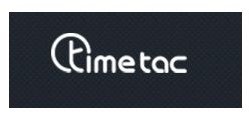
In today’s busy corporate world, we put in more work per employee per day than our predecessors thought possible. Tracking productivity and time worked has become more important than ever before: We need to know how much of our day is spent on tasks, what kind of work we did, how much that work cost us, and the amount of profit generated by that work.
TimeTac is an amazing cloud-based human resource and time management software that allows you to measure all of this—and a lot more as well. Some companies are simply using this product in the manner of a traditional time clock so that employees can be paid accurately. However, it goes beyond recording the time worked of those employees who pass through the company’s brick-and-mortar doors during the course of the business day.
Do you have employees whose chores take them outside the office? You need to track their time while they attend seminars or visit clients providing services as field or technical service representatives, for example. Many companies permit some of their employees to work from home, and TimeTac has what it takes to create accurate records for those employees. Imagine, too, the times when you perform a task for a client at a flat rate, or when you are documenting the billable services of a lawyer, an accountant, or even a social worker. Users can log on via the Internet or using their personal electronic devices. There is already an android application, and the company is finalizing production of an app for the iPhone.
Welcome to the Dashboard
When you log in, TimeTac takes you first to the Dashboard. The image shown lets us take a look at what employee Ann Evans is up to. Take note here of four primary areas:
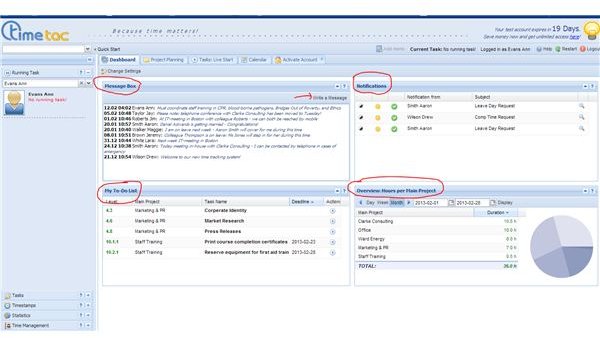
• The Message Box on the top left displays a running list of messages sent by others, and you can add messages of your own by clicking on the Write a Message button.
• On the top right are notifications. If you’ve requested a day off or if you’ve received approval to use comp time, this is the place to look. The magnifying glass icon allows you to read the details of the entry.
• The employee’s To-Do List is on the bottom left. This shows projects or tasks assigned including dependencies.
• On the bottom right you will see a pie chart identifying how the employee’s time has been spent. Upon opening it displays a breakdown for the current month, but you can change the dates to look at a specific time period or even just a day. If you are looking at this chart as a manager, the pie chart compares each employee’s total hours worked.
Menu Options
On the left-hand side of the dashboard, you will see a menu of Running Task, Tasks, Timestamps, Statistics, Time Management, and Settings. Running Task shows what that employee is working on at a particular moment. As the manager, you can drop down a list of all employees, select names of any or all employees, and see what all of them are up to any given time.
The Tasks category shows a list of tasks assigned to the employee. Clicking on the icon in the Actions column allows the employee to set the clock running on the task he is beginning. You can view a person’s entire list of tasks. The employee can also designate Tasks as favorites—those that are performed regularly, for instance—or those that he has just begun or added. This is a function that makes the software more user-friendly and easier to operate. Under the Settings category, you’ll learn more about Tasks.
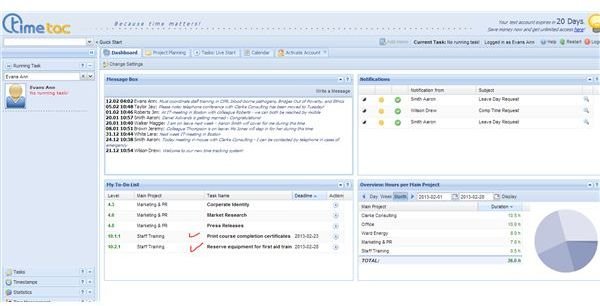
Note that the user cannot add tasks unless management has identified that as a permission for the user. If you are, in fact, the manager, this option gives you an overview of all tasks; you can choose from available employees and decide who will do what.
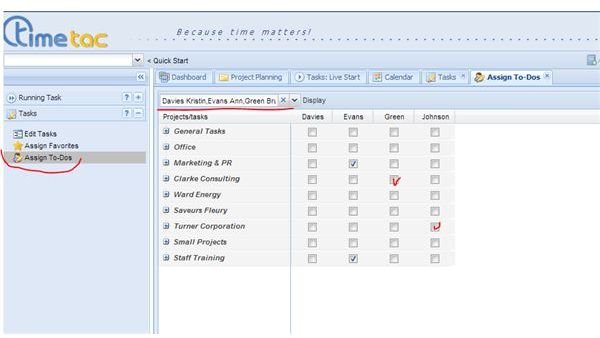
Timestamps validate the time and days spent working for various clients or on assorted tasks. Timestamps are activated when the user clicks on the name of the project or task currently being managed. The user can change them only if he attempts to shorten them; the manager must approve any deletion or lengthening of timestamps.
It is possible to modify them, however, to correct errors if an employee forgets to make the switch or if the employee stops to do something for one client in the middle of working for another. Timestamps are then displayed on the employee’s calendar and also as a list. The actual time worked is broken down on the Dashboard. The first image shows timestamps as displayed on the Calendar. To the right you see an employee’s list of timestamps. The image below them shows time worked in a pie chart on the Dashboard.

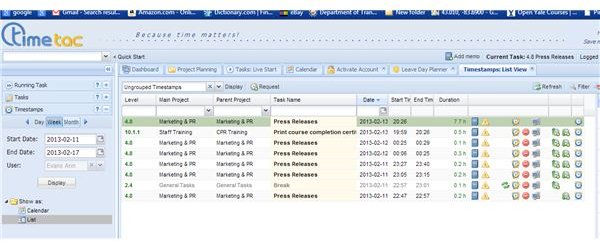
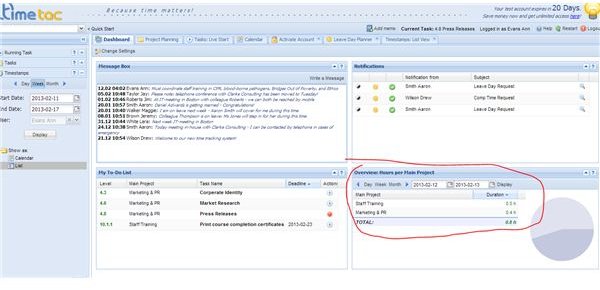
The Statistics menu option allows you to look at the employee’s work in a variety of ways—by all hours tracked as well as simply by billable or non-billable hours. In the image you can see that the Ms. Evans has worked 19 billable hours in the month of February. This is a very useful feature for billing clients, assessing staffing needs, and also for measuring an employee’s productivity.

Time Management offers a variety of useful features:
• Working Hours Overview allows you to see what hours the employee is expected to work versus what hours have actually been worked.
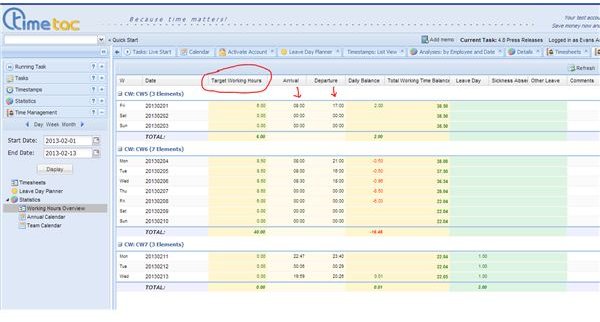
• A Leave Day Planner allows the employee to request time off.
• The Timesheets feature allows you to view an employee’s expected working days for the month or year. The image shows the yearly schedule for this employee. Note that PH indicates Public Holidays that a company manager has marked off on the calendar, which will show up for all employees. TimeTac will show you a list of regular holidays or you can input your company’s holiday schedule up to three years in advance. The employee has also requested CT or Comp Time in lieu of paid overtime as well as LD or Leave Days.
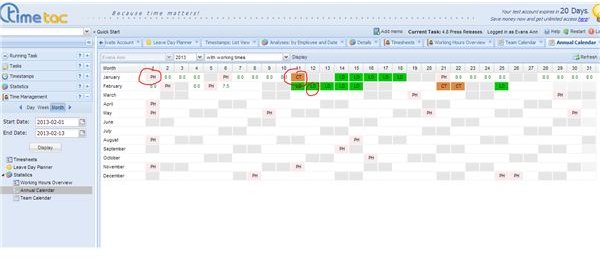
• There is also a Team Calendar, which lets the manager know who on his team is available at any given time, including sick days and vacation. There is also a calculation of available comp time if you prefer to utilize comp time in lieu of paid overtime.
The Settings button lets the employee change his contact information or password. The manager has many more uses with this option: He can view each employee and set privileges for him. He can also look at all of his employees in one view to see what settings he has applied. For example, our friend Ann Evans cannot log onto TimeTac using her mobile phone—a wonderful feature for mobile workers—while many other employees are assigned that privilege. The manager can also look at tasks to see which of his employees are authorized to perform various functions.
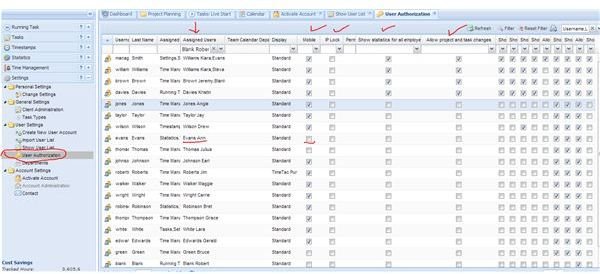
Under Settings you will also see Client Administration, and the image shows that we’ve added Acme Filmmaking as well as the client contact information, and this client even has the capability of logging onto TimeTac in case you want to give him that access. The program automatically assigns the client with a user name and login, which you can change at will, and you can deselect the TimeTac access option any time you like.
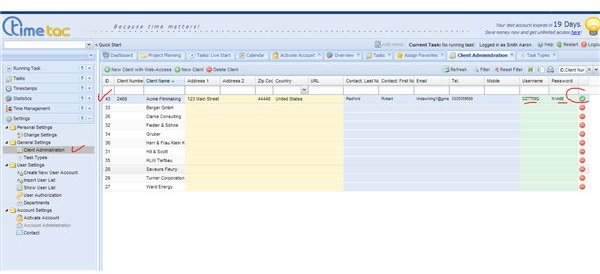
Here you will also identify your typical tasks and assign costs to them. Later on when you’re setting up tasks you can choose from this list and assign it to a client—suppose you are performing marketing tasks for your client—or you can create new tasks whenever necessary.
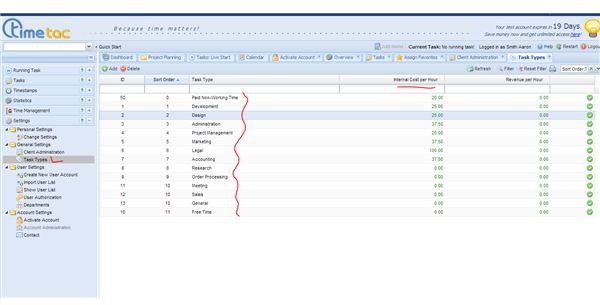
Project Planning
This tab along the top of the Dashboard allows the authorized user to specify exactly what he is doing for a client as he works. The image shows that for Clarke Consulting the manager may perform activities in the areas of Strategy Development, the Business Plan, the Finance Plan, or Implementation Monitoring, or in any of several areas that fall under the Change Management heading. Whenever a new client is added, you can specify whatever categories are applicable.
In the images below you will see that the manager has created a new project for Ann Evans to manage—Staff Training. Two courses are set so far, for CPR and for Emergency First Aid. They are set as sub-projects of the Staff Training Project, and you can see a task identified for the CPR course as Ms. Evans must prepare CPR course completion certificates. In the third image you can see we are adding another task for Ms. Evans (note that Tasks have Finance tabs), and the tasks will show up on Ms. Evans’ To-Do list on her Dashboard.
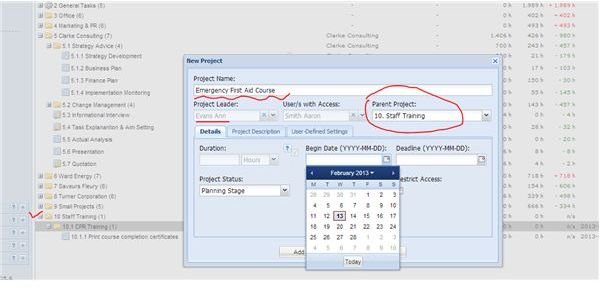
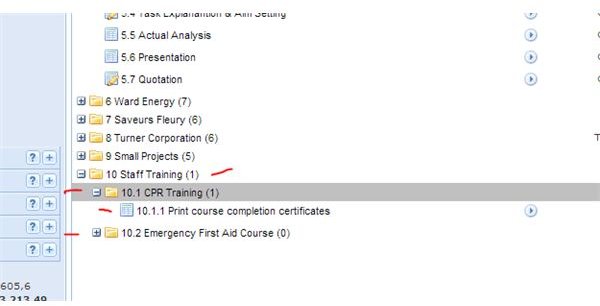
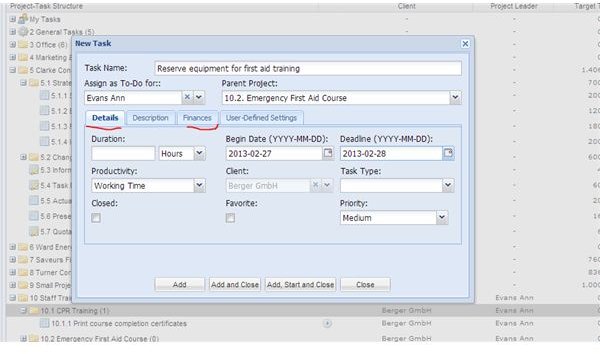
If you have tasks that you might perform for multiple clients, you can copy the steps of your task and assign them for those clients. Suppose you take the training that you’ve developed for your employees such as CPR and Emergency First Aid and you offer it as a package to your corporate clients. You can simply right-click on your project and choose Copy Project, and then select the clients for which it will be performed. This is especially useful when you have standardized tasks, so that you can calculate a time commitment and an internal cost that will remain uniform for that task across each client.
Generating Reports
You will also find options for importing and exporting data, with the latter an important feature for creating reports for your internal use or for your client. The image below shows the hours worked by Ann Evans on behalf of just one client, Clarke Consulting. To the top right of the image are icons so that you can export the data to an Excel spreadsheet or using a CSV format. Imagine how useful this is for invoicing your client. The options you have for selecting report data are endless.
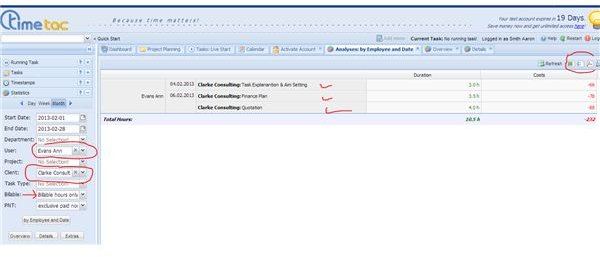
Help When You Need It
Many SaaS products offer little in the way of help. TimeTac, however, offers a very useful instruction manual that you can download with the product. The Table of Contents will direct you to instructions for both user and manager options. In addition, if you get stuck while you’re working, the Help button will take you on a tour and show you an indexed list of topics. Very nice, TimeTac!
Customizable Time Management Software: Thumbs Up
With all the options you’ve seen demonstrated in this overview, it’s difficult to imagine what else you might need. However, the company has the capability to customize the product for your specific needs. The software is modular-based and easily adapted per your requirements. You simply let TimeTac know how you want to document time as it applies to clients as well as employees, and the company can set it up the way you want.
Value per price passes muster as well, since you have options to fit your budget. You can use it simply as a time punch for employees or you can buy the Light or Pro versions that offer much more. To simply track and accurately pay the time worked by about 50 employees, you’d be paying about $140 per month, not a bad deal at all. The Light and Pro versions cost more but still provide significant efficiency over a wide assortment of services. This reviewer comes away with a solid feeling that the more you use this SaaSy product, the more uses you will discover.
References
- The writer is an experienced reviewer and utilizer of project management software.